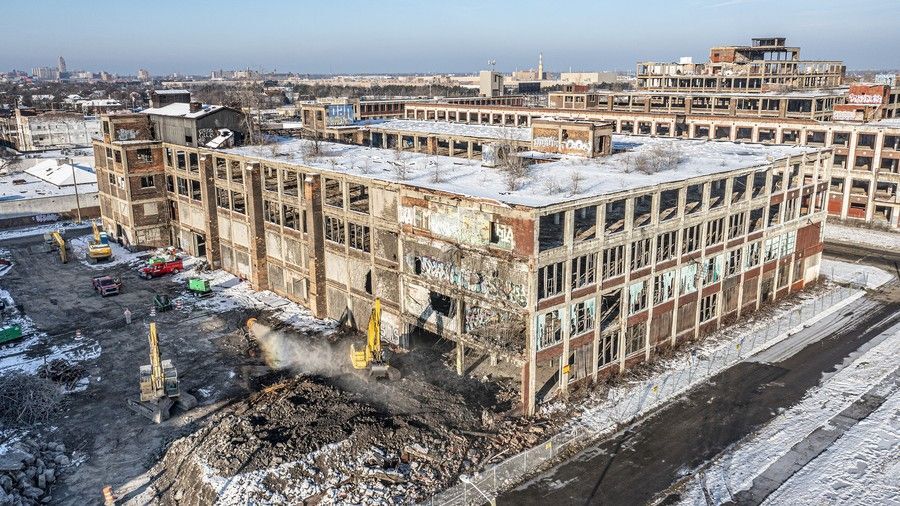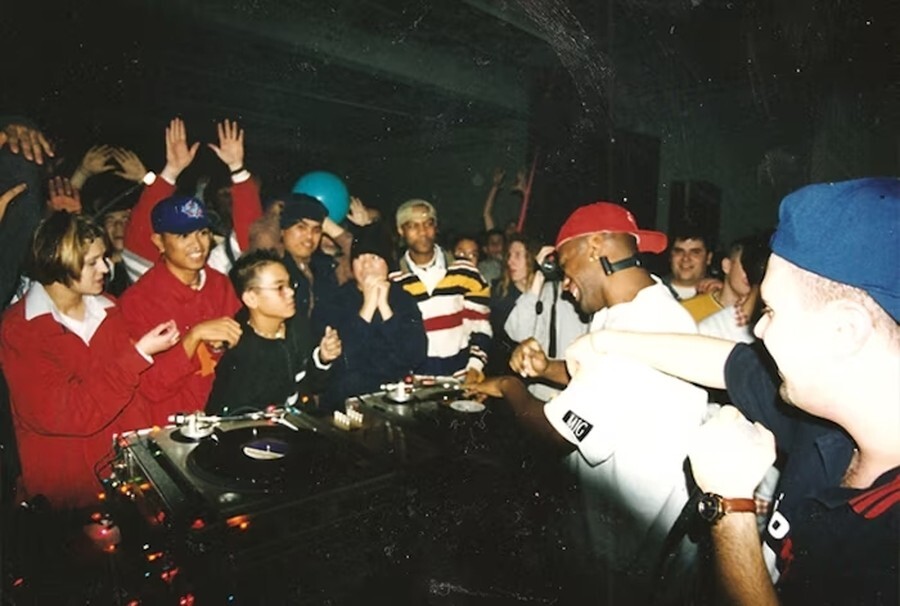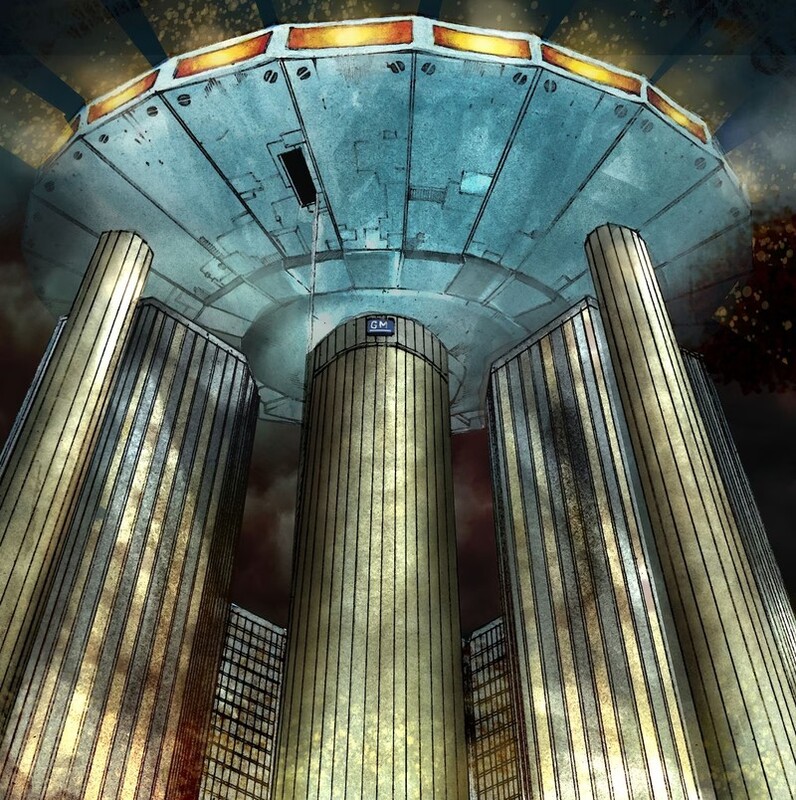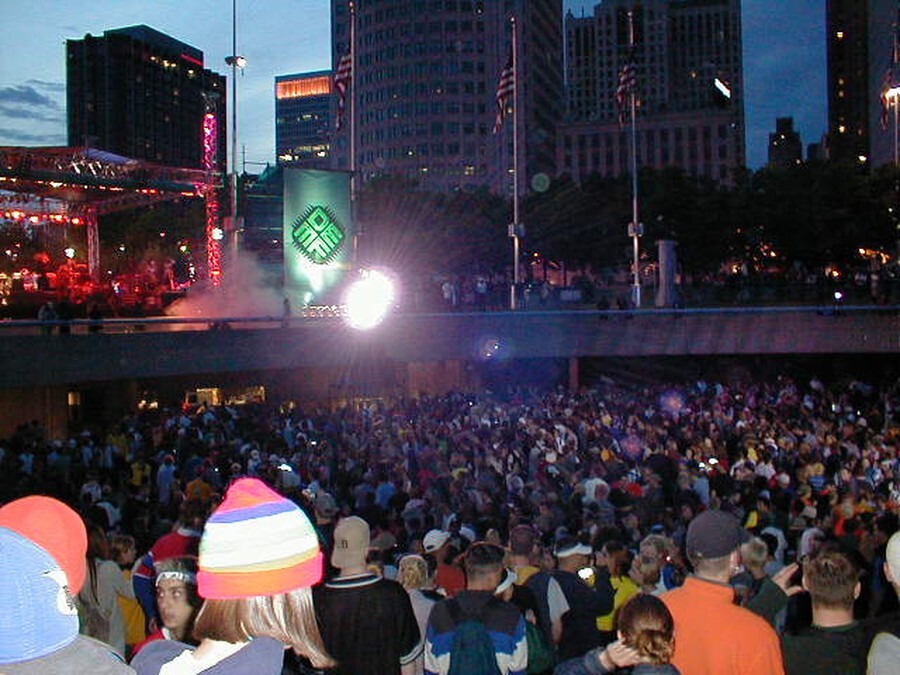
Detroit Ecstasy: Ruminations on Raving, “Movement” and Place
Oakland University (US)
<https://dx.doi.org/10.12801/1947-5403.2023.15.01.08>
In October 2022, I was driving down I-94 on Detroit’s east side and noticed that parts of the famed Packard Plant were being torn down. Located less than four miles east of the Motown Museum, the long-abandoned car factory is known to many Gen Xers as the premiere rave space where Richie Hawtin and his entourage threw parties in the early to mid-1990s. My foray into raves and techno came just three months too late to attend one of these legendary events, but if there were two such spaces in Detroit that I could go back in time to experience, then the Packard would definitely be number two, right behind the Music Institute at 1315 Broadway, where Derrick May DJed and the Detroit techno sound incubated in the late 1980s.

Figure 1. Packard Plant 2023. Photo credit: Larry Peplin (2023).

Figure 2. Gary Chandler DJing at a DJ Godfather vs DJ Gary Chandler Poor Boy Party at the Packard Plant. Photo credit: Brian Gillespie (1997).
If you hadn’t experienced Detroit in the 1980s or 1990s it’s difficult to fully comprehend the state of the city at the time. The decline of the auto industry that began in the 1970s accelerated a crisis that was already well underway. As jobs left, the tax base dwindled, schools closed, crack took a hold and crime surged. In his 1993 book Afterculture: Detroit and the Humiliation of History, Jerry Herron sums up the impact of these economic and social conditions with this blunt statement:
Detroit—more than any other spot in this country—has been so thoroughly humiliated by history, so emptied of the content, both material and human, that used to make this place mean, that it becomes questionable whether the city still exists at all in any practical sense". (1993: 14; emphasis in original)
At the time, Detroit’s population was just over one million—down by nearly 50% since its peak in 1950—and three quarters of its residents were African American. Despite all of the challenges they endured, life was far from devoid of meaning—and consequence—for Detroiters at this time. Turning to music to express themselves, to respond to the conditions of everyday life, and to build community was a long-ingrained practice in the city. In the early 1980s, the Electrifying Mojo would begin his nightly radio show with the “landing of the mothership”—a nod to George Clinton’s Afrofuturism before the term existed. Mojo’s sets explored genres and artists that were not typically played on Black radio. In one set, listeners could hear deep cuts from Prince, New Order, Kraftwerk and the J. Geils Band. The city’s pioneering techno producers and DJs cite Mojo and his eclectic sets that cut across the color line as immensely influential on their musical development.

Figure 3. Artist rendering of the Electrifying Mojo’s mothership. Photo credit: Abdul Qadim Haqq (2015).
Somehow, it’s been 27 years since I entered the world of electronic dance music and rave culture. I use the word entered quite literally. It didn’t happen in Detroit but across the river in my hometown of Windsor, ON. I was 19 at the time and had gone to an AIDS benefit drag show with some friends who insisted that we go to this party afterwards and that I was going to love it.
Later that night, instead of heading east, I drove us to the city’s west end, unaware of how life changing this detour would prove to be. A field of cars and booming bass sounds signaled that we were in the right place. It was already midnight. I had a head cold and was worried about how I was going to stay awake but then one of friends pulled some tiny paper squares out of his pocket that the four of us consumed without hesitation. So many questions swirled in my mind as I paid the $10 cover charge. Like why was the hallway covered in black plastic, and how was it even possible that I was hanging out in an elementary school at midnight on a Saturday?! We headed into the gym and I was floored by what I saw and heard: two girls with glow in the dark nail polish dancing together off to one side—“cool”; and beyond them a couple hundred people dancing, all facing the DJ. Huh, looks like an aerobics class I thought. Then I heard a sample from MLK’s “I Have a Dream” speech and thought, Ok what’s this really all about? The acid hadn’t even started to kick in yet but it didn’t take long for me to know. This was the beginning of what exactly I wasn’t sure but definitely something. We spent the next several hours dancing to homegrown Detroit house and techno. It just went on and on without any breaks; one long soundtrack to this life-altering night. I don’t remember much about the acid’s effects except that it felt like my cold had magically vanished and been replaced with an hours-long burst of energy. I danced a lot and couldn’t make much sense of what I was hearing but felt drawn to all of it in a profound way. I had stepped into a particular kind of “intimate public,” one that Garcia-Mispireta builds on in his analysis of stranger-intimacy on the dance floor (2023). My best friend was our “home base” and throughout the night she introduced me to “Tracy from the Detroit area” and other party-goers; these were the most sociable strangers I’d ever encountered. Maybe this was because of the ecstasy that I would soon learn was the raver drug of choice. I found it fascinating that gender protocol didn’t apply to the bathrooms where dozens of people hung around communal sinks talking about DJs and parties while smoking weed and somewhat discreetly partaking in other drugs. I had no language or reference points for any of it. As the sun came up the acid’s effects slowly dissipated, but the music’s four on the floor bass sounds and the urge to dance lingered within me for days. It would take a while for me to learn the terminology and to be able to recognize the intricacies and subgenres of the music and to learn what makes a good DJ set and party; but if there was one thing I was good at, it was studying.
It didn’t take long for me to learn that much of this future oriented music I fell in love with was actually from Detroit, a city just a bus ride away where I spent my high school years record shopping and going to concerts. Years later, reading narratives that compare nights spent at legendary house clubs like The Music Box in Chicago and Paradise Garage in New York to going to church, it dawned on me that on 20 January 1996, I had experienced a baptism of sorts.
For the next few years I was engrossed in PLUR naivety and the playfulness and experimentation that rave culture inspired. We found freedom in gender fluid fashion and as Mireille Silcott writes in Rave America, “gobbled too many Es, said ‘dude’ a lot … and pierced the dickens out of [our] bodies” (1999: 45). Parties were where new tracks were dropped and innovative fashions flaunted. It’s where a new generation of kids experienced the queer time that disco bore and a sense of collective effervescence and self-affirmation that was unmatched in daily life. Gina Arnold argues that in these spaces participants’ identities are “explicitly stated, both to themselves and to others, but rather than attaching to individuality, identity is attached to the idea of becoming an anonymous crowd member” (2018: 128). For an introvert like myself, the simultaneous experience of belonging and anonymity was too seductive.
By the end of the nineties the scene in Detroit has fizzled out due to overexposure, greed, commercialism and criminalization. Even cities like Toronto, that had initially adopted a "nonreactionary stance" to parties because they saw the benefits in keeping kids off the streets (Silcott 1999: 83), changed their position as rave culture gained more popular press coverage. Meanwhile, well-established moral panic in the UK made their way across the pond. By this point, Detroit’s approach to illegal parties, like that of most US cities, became increasingly punishing. Promoters and patrons were criminalized and threatened with severe penalties that included the confiscation of equipment, heavy fines and even jail time. And with that, dancing all night in warehouses, abandoned theaters and bingo halls, to techno, house and the occasional ghetto tech set, came to a halt. And the challenges the city was facing weren’t all that different from the previous decade. Down another 70 000 residents, the city was now 82% Black and still struggling to turn its troubles around.
It was in this context that the Detroit Electronic Music Festival (DEMF) was founded in 2000. Up to this point, the city—like the US as a whole—had paid little attention to the local artists who pioneered a new genre of music that had captured the imagination of millions of people worldwide. By now, most of them were living in European cities where they could capitalize on dance music and club culture’s popularity. The history of techno as Black music had to a large extent been white-washed, even within Detroit, the Blackest city in the nation, where it had all begun. The inaugural festival took place at Hart Plaza on the city’s waterfront over Memorial Day weekend. It was free and organized to showcase the talent that emerged from the city and to gather the region’s divided populace. EDM producer and DJ Carl Craig served as artistic director. Leading up to the festival he remarked:
I feel that the diversity of the people this event could draw will help expand the cultural diversity within Detroit … different cultures coming to the city that don't usually get together … I think that this can help to develop the image that people have of Detroit. (Glazer: 1999)
Like the Grand Performances in Los Angeles that Marina Peterson documents in her book Sound, Space and the City, DEMF was also a civic performance that first and foremost was intended for the city and its people. The hope was that it could draw suburbanites back from north of 8 Mile and down river; and that, through this communal experience, it could begin to heal some of the deep racial tensions that still plagued the region. The music could not only entertain but also uplift and give the city’s image a much-needed boost.

Figure 4. Detroit Electronic Music Festival. Photo credit: Mike Davis (2000).
In hindsight, Craig’s statement can also be read as an early example of evolving “eventful city” and “festival city” discourses (Richards and Palmer 2010: 2-3). As Fabian Holt explains, “these discourses focused on the impact of festivals on the local economy, building on developments within postindustrial economies of tourism and place marketing” (2021: 230). Detroit is not a typical tourist locale, but techno fans by the thousands continue to show up every Memorial Day weekend.
Local media reported that somewhere in the vicinity of one million people attended the first DEMF over its three days. The numbers have been debated but their accuracy is inconsequential. In his review, Detroit Free Press columnist Brian McCollum noted, "they came—hundreds of thousands ... with bald heads, frizzy Afros, green hair, purple hair and everything in between" (2000: C1). Like Herron before him, McCollum went on to mythologize the moment, writing: "When darkness fell, they were—all of them—simply Detroit. This was the moment when the Detroit Electronic Music Festival went transcendent. This was the moment when Detroit techno arrived". Detroit techno had been evolving for nearly two decades by this point, but McCollum’s reporting plays into the appeal of the party, that when one enters its physical and sonic space, everyday life is left behind and new experiences materialize. To say the crowd was “simply Detroit” is to affirm Craig’s desire, and that of other hopefuls like Berlin-based music psychologist Stefan Koelsch, who believe in music’s ability to increase cultural cohesion; the belief that through collective experience we can really see one another. With respect to public concerts specifically, Marina Peterson notes that they provide “a space in which an ideal of and for social relations, and for the city is realized through experience” (2010: 15). The local press, organizers and presumably the city officials who greenlighted DEMF seem to share these sentiments.
Soon after the festival, a Ford Focus commercial featured a cyborg-like entity that was half-DJ and half auto-plant robot, the soundtrack to which was Model 500’s "No UFOs". Noting the success of the festival, Ford stepped in as the primary sponsor the following year. The partnership capitalized on Detroit techno’s origin story; that the sounds and sites of factory work and deindustrialization are what inspired the first wave of artists to envision new sounds and alternative ways of being in the world. With Ford’s official endorsement and national advertising campaign Detroit techno was momentarily mainstream. However, it would take another decade for what became known as EDM to really seep into pop music and the country’s collective consciousness.
In 2006, DEMF became Movement and it was around this time that we saw an explosion of EDM festivals in the US, which helped ensure its continued success. Movement still takes place every Memorial Day weekend in the same place, at Hart Plaza on the waterfront downtown, but a global fan base has supplanted a local one. More than 20 years in, its audience is whiter and wealthier. What was once a free festival now costs hundreds of dollars to attend. Following the festival trend, production costs and admission have continued to skyrocket as has the need to acquire big brand sponsorships. In this sense, its production company Paxahau is operating within market logics and “soft shell” tactics—strategies that make it appealing to a wider audience. For instance, it’s not uncommon for one of its stages to be dedicated to pop-EDM that attracts a younger, more mainstream crowd and like other major festivals it has surrendered to the “headliner economy” with artists like Kraftwerk and Richie Hawtin and hip-hop acts Wu Tang Clan and Public Enemy closing out nights over the years. Paxahau’s approach is understandable given that festivals are now “one of the main sources of revenue for artist agencies, managers and booking agencies” (Holt 2021: 227). Holt argues that for festivals like Tomorrowland and Electric Forest humanist values have all but disappeared. Admittedly, it’s been a while since I’ve attended the festival but I like to think that Movement has maintained what Holt calls its “hard core”—that it hasn’t entirely succumbed to mass culture tastes and corporate logics. It remains independent and continues to spotlight Detroit artists, thus invoking—at least on some level—early Detroit techno musicians’ inspirational sounds that sought to develop imaginative potential and possibilities that seemed unavailable to many at the time, especially in the inner city. Maybe this is wishful thinking.
All of this thinking, writing and reminiscing has left me with a collection of conflicting thoughts and emotions. I’m grateful for the artists and the music, for being in the right place at the right time to have had these experiences, but also mournful that while techno’s mark on the city has endured, its connection to the people of Detroit fissured long ago. A number of factors impacted this disconnect early on including its (re)packaging as a white, European form of cultural expression for the masses; a discursive framework that overlooked its humanness and a lack of industry support in the US. But launching DEMF as a free festival harked back to an earlier time when free, public performances were commonplace in the city. It also created the conditions for cultural connection at the level of ideology and affect. But it was only a matter of time before the festival had to start charging an entrance fee which it did in 2002. In addition, the idea that a crowd could be “simply Detroit” was devoid of meaning or vision. I can confidently say that there’s little that is simple about Detroit or its people.
A full decade has passed since Detroit filed the largest municipal bankruptcy in US history and while an uptick in investment has resulted in visible changes to the city’s downtown and Midtown core, many residents continue to struggle with issues like neighborhood de-investment, lack of affordable housing and high employment. In the face of these challenges, music-making and community-building are more intertwined and prevalent now than ever. Techno itself doesn’t quite resonate with African American youth in the city today compared to prior generations, but its DIY aesthetic, inventiveness and entrepreneurial zeitgeist persists.
Inspired by oldschool artists like J. Dilla and Slum Village, and newer emcees like Quelle Chris, Tee Grizzley and B Free, today hip-hop is the music of choice among Detroit youth. Entrenched in the city’s musical legacies, they are creating collectives by the dozens and beats on every block; they are converting vacant properties into performance and studio spaces. And the term “networking sideways”—popularized by Adrian Tonan who recently served as Detroit’s first 24hour economy ambassador—is gaining traction as they fuse music and technology to speak their truths, spark creativity and cultivate community, in the footsteps of their forebears.
As for me, I still attend a Movement afterparty every now and then. “No Way Back” in particular is a celebrated event among the old school where I’m guaranteed to run into acquaintances, friends and familiar bodies. The music is stellar, the aesthetic minimal, the vibe PLURacious; and for this one night I’m back in church, lost in the crowd, dancing like no one’s watching.

Figure 5. No Way Back flyer. Photo credit: Interdimensional Transmissions (2023).
Rebekah Farrugia is Professor of Communication with a specialization in media and popular music studies at Oakland University in Rochester, Michigan. Her scholarship explores the relationships between gender, race, community and place in contemporary music genres such as electronic dance music and hip hop. Her books include Women Rapping Revolution: Hip Hop and Community Building in Detroit (University of California Press) co-authored with Kellie D. Hay and Beyond the Dance Floor: Female DJs, Technology and Electronic Dance Music (Intellect Press).
Arnold, Gina. 2018. Half a Million Strong: Crowds and Power from Woodstock to Coachella. Iowa City: University of Iowa Press.
Garcia-Mispireta, Luis Manuel. 2023. Together, Somehow: Music, Affect, and Intimacy on the Dancefloor. Durham: Duke University Press.
Glazer, Joshua. “Time Has Come”. Real Detroit Weekly. December 9, 1999. <www.getrealdetroit.com/coverstory.htm>, (accessed March 15, 2001).
Herron, Jerry. 1993. Afterculture: Detroit and the Humiliation of History. Detroit: Wayne State University Press.
Holt, Fabian. 2021. Everyone Loves Live Music: A Theory of Performance Institutions. Chicago: University of Chicago Press.
Koelsch, Stefan. 2013. “From Social Contact to Social Cohesion—The 7 Cs”. Music and Medicine: An interdisciplinary journal, 5(4): 204-209. <https://doi.org/10.1177/1943862113508588>.
McCollum, Brian. “Technotown”. Detroit Free Press. 30 May 2000, C1-2.
Peterson, Marina. 2010. Sound, Space and the City: Civic Performance in Downtown Los Angeles. Philadelphia: University of Pennsylvania Press.
Richards, Greg and Robert Palmer. 2010. Eventful Cities: Cultural Management and Urban Revitalisation. New York: Routledge.
Silcott, Mireille. 1999. Rave America: New School Dancescapes. Toronto: ECW Press.